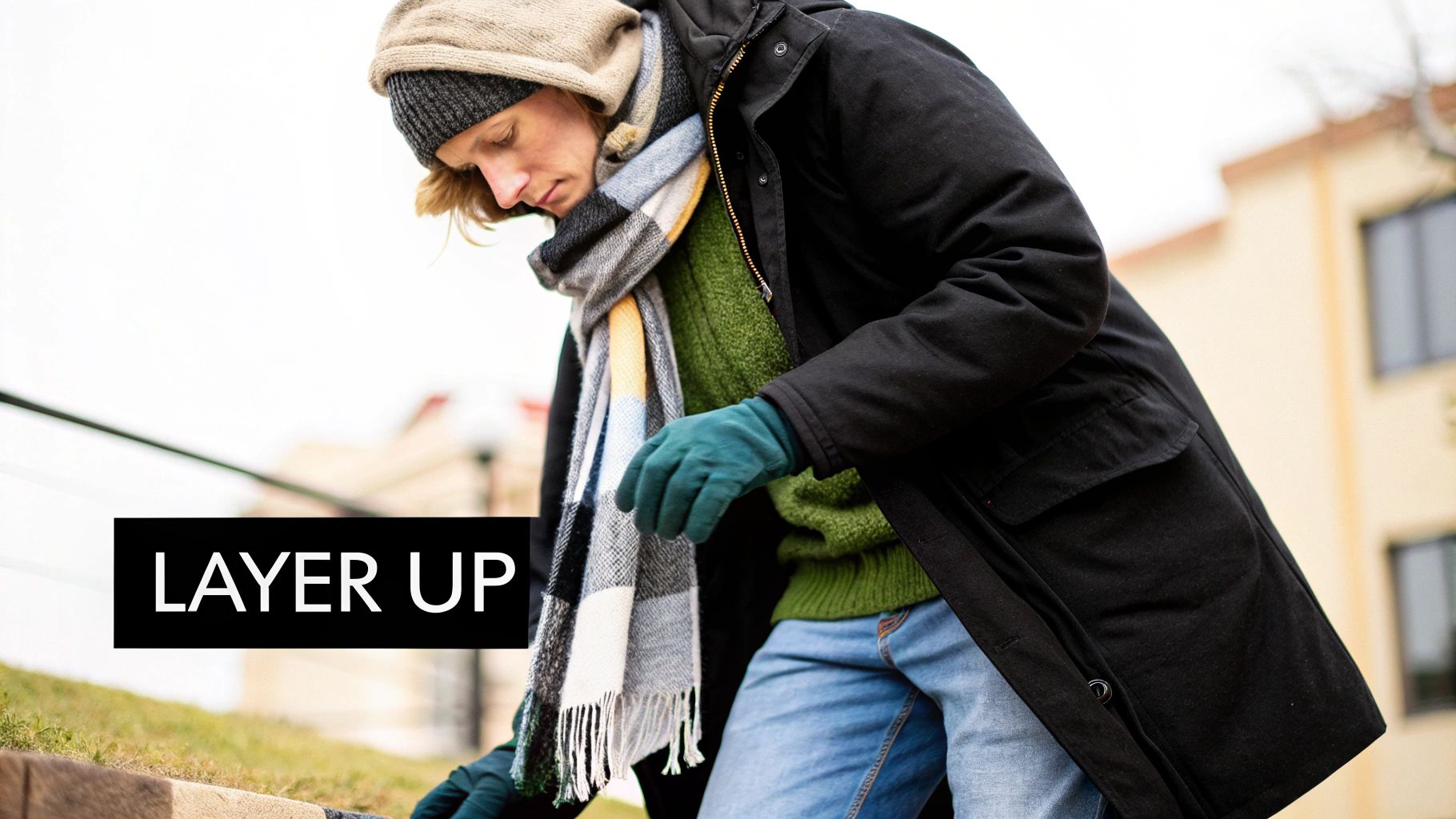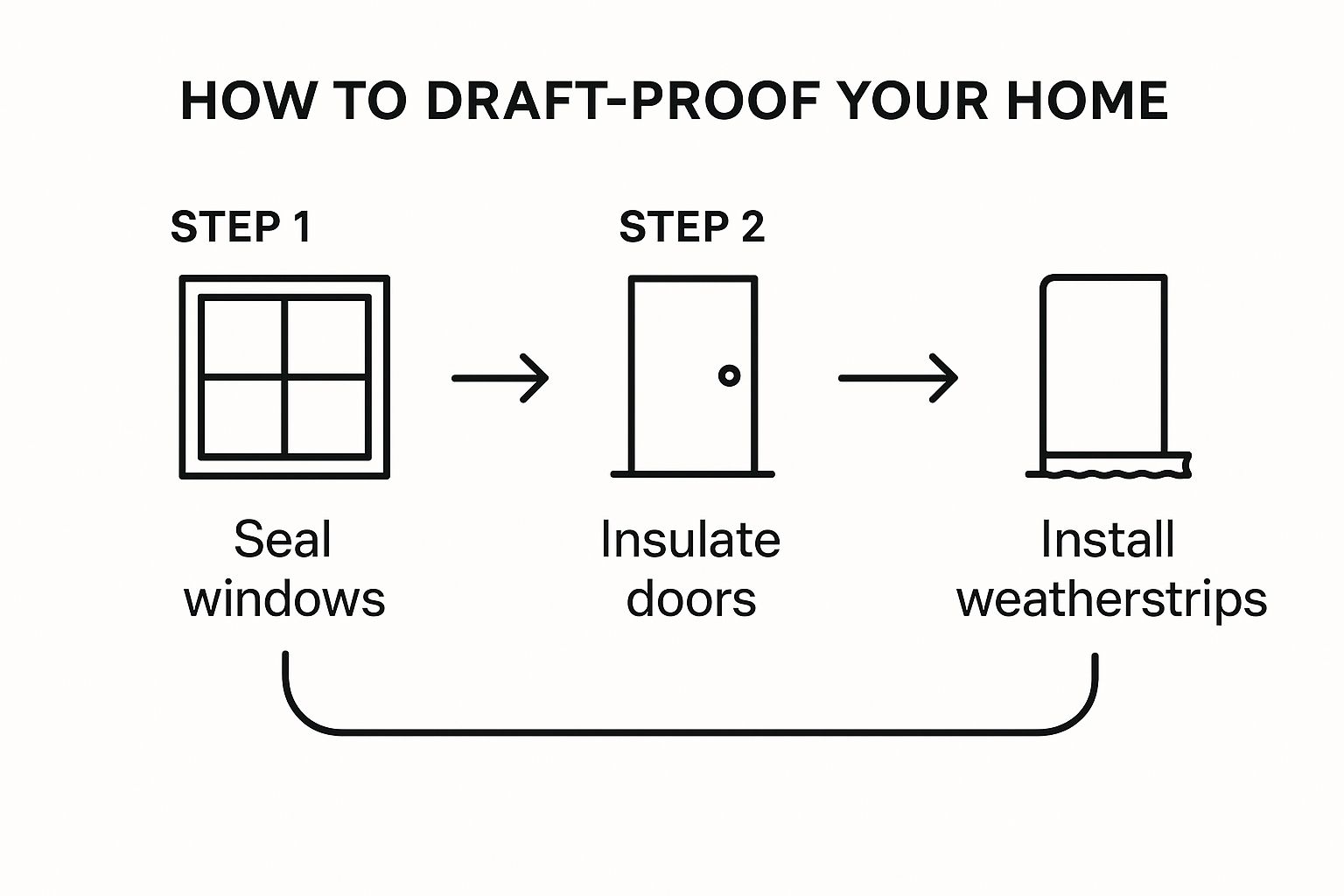When the British winter arrives, staying warm is about more than just turning up the thermostat. The real secret is a smarter approach, blending personal comfort with a few clever home adjustments to create a genuine sanctuary from the cold.
Your Guide to a Warmer Winter
There is nothing quite like feeling properly warm and comfortable during the colder months. It is a huge part of your wellbeing, that sense of security you get when you are settled in at home. While it can sometimes feel like an annual fight against the dropping temperatures, a few thoughtful strategies can completely change the game.

This guide is all about practical, helpful advice that actually works. We will cover everything from smart clothing choices to simple home tweaks that make a noticeable difference. Let's get started.
The Modern Approach to Keeping Warm
Our whole idea of indoor comfort has changed dramatically over the decades. Better home heating is the main reason, as the number of UK homes with central heating shot up from just 31% in 1970 to over 91% by 2006. That massive shift made our homes far cosier than they were for our parents or grandparents.
This means we can now be a lot more strategic about warmth. We do not just have to rely on the central heating blasting away. We can look at other key areas to keep things comfortable.
A truly warm home is a mix of smart heating, good insulation, and personal comfort choices. It is not one big fix, but lots of small, supportive actions working together.
One of the best places to start is with your own personal space. For example, a high-quality comforter is brilliant at trapping your body heat, creating a warm pocket of air that guarantees a restful night's sleep. The best part is that you do not have to overheat the entire room. You can find out more about choosing the perfect duvet and comforter for your needs. The goal is to build layers of warmth into your home and daily routine.
Your At-a-Glance Winter Warmth Plan
Here is a quick summary of the most effective strategies for staying warm, covering personal, home, and lifestyle tips.
| Strategy Area | Key Tip | Why It Matters |
|---|---|---|
| Personal | Wear layers of natural fibres like wool or cotton. | These fibres are excellent at trapping air, creating an insulating barrier that keeps your body heat in. |
| Home | Block draughts around windows and doors. | Even small gaps can let a surprising amount of cold air in, making your heating system work much harder. |
| Lifestyle | Enjoy a warm drink before bed. | A warm drink like herbal tea can gently raise your core body temperature, helping you feel cosy and relaxed. |
Think of this table as your starting point. By focusing on these three areas, you create a complete plan that tackles the cold from every angle, ensuring you stay comfortable all winter long.
Mastering the Art of Layering
When the temperature really starts to drop, the secret to staying genuinely warm is not one big, bulky coat, but smart, lightweight layers. This simple technique gives you incredible control over your body temperature, so you can easily adapt as you move from the biting cold outside to a centrally heated office. The magic lies in trapping air between each layer, which is nature’s best insulator.
It is a tried and tested system that relies on three distinct layers, each with its own role to play. Think of it as a team effort, with each piece working together to keep you comfortable.
Your Three-Layer System
First up is your base layer. Its most important job is to wick moisture away from your skin. This means if you start to sweat, this layer pulls that dampness away, which is crucial for staying dry and warm. Natural fibres like merino wool are brilliant for this because they are breathable and regulate temperature without getting clammy.
Next, you need a mid-layer. This is your primary insulation, the one that does the heavy lifting of keeping you warm. It could be your favourite fleece, a classic wool jumper, or even a lightweight down gilet. Its purpose is to trap the body heat your base layer is working to preserve.
Finally, the outer layer is your shield against the elements. A decent waterproof and windproof jacket is essential here. It stops rain and wind from getting through, which effectively locks in all that lovely warmth you have built up underneath.
Layering is much more effective than a single thick garment because the air trapped between the fabrics provides powerful extra insulation. It is a small change in approach that makes a world of difference to how comfortable you feel.
While getting your clothing layers right is key, the same principle works wonders for your home. You can create layers of warmth in your living space, too. Adding a cosy fluffy white comforter to your bed, for example, turns it into a warm sanctuary without needing to turn up the thermostat for the whole house.
This infographic breaks down a similar layering concept for your home, showing how things like sealing windows and insulating doors can trap warmth inside.

Just like multiple layers of clothing protect you from the cold, taking a few simple steps to draught-proof your home creates an essential barrier that keeps the winter weather firmly outside.
Creating a Cosy and Draught-Free Home
When the winter chill sets in, your home should be a warm retreat, a place you can truly unwind and escape the cold. You do not need to start expensive renovations to achieve this. Often, a few simple, thoughtful changes are all it takes to keep the cold out and trap that precious warmth inside.

The biggest culprit stealing your home's heat is sneaky draughts. Those small, almost invisible gaps around windows and under doors can let in a shocking amount of cold air, making your heating system work overtime just to keep up. A simple draught excluder at the base of a door is a quick and easy win. For windows, self-adhesive foam strips are a cheap and surprisingly effective way to seal things up.
These small fixes are about more than just comfort, they are essential for wellbeing. It is a sobering fact that in the UK, thousands of excess winter deaths have been linked to cold homes. This really drives home how vital it is to keep our living spaces properly insulated. You can learn more about the impact of cold homes on public health and understand why these simple measures are so critical.
Smart Ways to Trap Heat
Once you have sealed the leaks, it is time to get clever about trapping the heat you generate. Think of it as creating layers of insulation throughout your living space.
- Upgrade Your Curtains: Switching from thin summer curtains to a thicker, thermal-lined pair is one of the most effective things you can do. They create a powerful barrier against cold glass, trapping a layer of air that acts as an insulator, especially overnight.
- Use Rugs Strategically: A thick, plush rug on a wooden or tiled floor does more than just feel lovely underfoot. It adds a crucial layer of insulation, instantly making a room feel warmer and more inviting.
- Check Your Furniture Placement: Is your favourite armchair or sofa pushed right up against a radiator? Pulling it forward just a few inches can make a huge difference, allowing warm air to circulate freely around the room instead of being absorbed by your furniture.
Think of your home’s decor as another tool in your winter warmth kit. Every rug, curtain, and throw can play a part in creating a genuinely snug and inviting atmosphere.
These practical changes not only contribute to a warmer environment but might even inspire you to refresh your space. For more ideas on turning your rooms into comfortable sanctuaries, check out our guide on the best bedroom decor ideas.
Warming Up from the Inside Out
It is easy to forget just how much what you eat and drink can affect how warm you feel. When the temperature drops, turning to food and drink is not just about comfort, it is a genuinely effective way to stoke your internal furnace and raise your core body temperature.
Think of it as heating yourself from the inside. Regular, hot meals are a key strategy for staying warm through winter. The act of digestion, known as thermogenesis, naturally creates energy and heat.
Foods That Fuel Your Inner Furnace
In the colder months, hearty, slow-release carbohydrates are your best friends. Your body takes longer to break them down, which means they provide a slow, steady release of heat over several hours.
- Porridge and Oats: You cannot beat starting the day with a warm bowl of porridge. It delivers that slow-burning energy needed to keep you feeling warm and satisfied right through the morning.
- Soups and Stews: A nourishing, hot soup is the ultimate winter meal for a reason. It warms you from the first spoonful and is a brilliant way to pack in plenty of vegetables.
- Root Vegetables: Carrots, sweet potatoes, and parsnips are perfect for roasting. As complex carbohydrates, they help your body maintain a stable temperature.
Smart Sips for Staying Warm
Staying hydrated is just as crucial in winter as it is in the peak of summer. A warm drink offers immediate comfort and helps to keep your core temperature up. Things like herbal teas, hot chocolate, or even a simple mug of hot water with lemon are all fantastic choices.
A warm drink does more than just warm your hands. It works from the inside, gently raising your body temperature and providing a feeling of deep comfort that lasts.
It is a common myth that a tot of brandy will warm you up. While it might give you a fleeting feeling of warmth, alcohol actually causes your blood vessels to dilate, leading you to lose body heat more quickly. For genuine, lasting warmth, it is best to stick with non-alcoholic options.
Just as food warms your core, creating a cosy environment is essential. For some great tips on your sleeping space, you can learn how to make your bed more comfortable and beat the overnight chill.
Simple Tips for a Warm Night's Sleep
There is nothing worse than a cold bedroom stealing a good night's sleep, leaving you shivering when you should be resting. The secret to staying comfortable all winter long often lies in creating a warm, inviting sleep environment, and that process starts with your bed.
Getting your bedding right can make all the difference. When the temperature drops, it is the ideal time to swap to a duvet with a higher tog rating, something between 13.5 and 15 is perfect for winter. The tog number is just a simple measure of thermal insulation, so a higher number means it traps more heat, keeping you much cosier. I also recommend switching to brushed cotton or flannel sheets. Unlike crisp percale, which can feel quite chilly when you first get in, these materials feel instantly warm and welcoming.
Creating Your Cosy Sleep Sanctuary
Beyond the duvet itself, a few simple habits can turn your bed from a cold spot into a warm haven. These little tricks can seriously boost your comfort levels without having to turn up the heating for the whole house.
- Pre-warm Your Bed: The classic hot water bottle is a wonderfully effective and cheap way to take the initial chill off your sheets. Just pop it in your bed about 10 minutes before you plan to turn in.
- Dress for the Occasion: Do not underestimate the power of warm pyjamas. Flannel or fleece are brilliant choices for nightwear. And whatever you do, do not forget your feet. A pair of soft socks can do wonders for regulating your body temperature and helping you drift off.
It is interesting to note that the UK climate has been changing, with recent winters becoming warmer but also noticeably wetter. That dampness can make the cold feel far more penetrating, which is why focusing on your immediate sleeping environment, your bed, is such a smart and effective strategy for staying genuinely warm. You can read more about how UK winters are changing and see why a multi-layered approach to warmth works so well.
While a warm bed is a must, the ideal room temperature for high-quality sleep is actually on the cooler side, around 18°C. This creates the perfect balance for deep, restorative rest.
At the end of the day, a comfortable night's sleep is a cornerstone of your overall wellbeing. By making these small, deliberate adjustments, you are not just staying warm, you are actively practising good sleep hygiene. You can explore more expert advice in our guide to what is good sleep hygiene and learn how it supports a healthier, more rested you.
Your Winter Warmth Questions Answered
We get asked all the time about the best ways to keep warm when the temperature drops. Here are our answers to some of the most common questions we hear, packed with practical advice to keep you and your family comfortable all winter.
Is It Cheaper to Leave My Heating on Low All Day?
This is a classic debate, but for most homes with decent insulation, the answer is no. It is actually more cost-effective to use a timer. Modern boilers are incredibly efficient at getting a room up to temperature quickly, so letting them work their magic when you actually need them is the smarter move.
Leaving the heating on a low setting all day often means it is running for hours when nobody is there to enjoy it. Now, if your home is older or struggles with insulation, it might take a huge amount of energy to bring it back from cold. For the majority of us, though, programming your thermostat to match your daily routine is the best way to manage your energy bills.
What Is the Ideal Room Temperature for Winter?
For general comfort during the day, health organisations like the NHS recommend keeping your main living spaces between 18°C and 21°C. This range feels pleasant without making the air feel stuffy or dry.
When it comes to the bedroom, a slightly cooler temperature of around 18°C is widely considered best for a restful night’s sleep. It is particularly important to maintain at least this temperature in rooms used by young children, elderly family members, or anyone with underlying health conditions.
How Much Electricity Does an Electric Blanket Use?
You will be happy to hear that modern electric blankets are surprisingly light on the wallet. They cost just a few pence per hour to run, making them a brilliant, budget-friendly way to get cosy.
Think about it, switching one on to pre-warm your bed for 30 minutes before you jump in is far cheaper than trying to heat the entire bedroom for hours. It is a fantastic little trick that guarantees you will be slipping into a toasty bed without worrying about a big electricity bill.
Do I Lose Most of My Body Heat Through My Head?
This is one of those old myths that just will not go away. The idea that a massive percentage of body heat escapes through your head is not really accurate. The truth is, you lose heat from any part of your body that is left exposed to the cold.
Your head often feels the coldest simply because it is usually uncovered. So, while a hat is always a great idea, it is not a silver bullet. The real secret to staying warm is covering all exposed skin, think hands, neck, and head, for total protection against the chill.
Ultimately, staying truly comfortable is about combining a few smart strategies. By layering your clothes, making a few small adjustments around the home, and understanding your heating system, you can create a warm, inviting space to see you through the season.
For the ultimate in bedtime comfort, discover the buttery-soft feel and cloud-like warmth of a Snuggle Comforter from Morgan and Reid. Explore our collection and make this your cosiest winter yet at https://www.morganandreid.com.



Share:
Choosing Animal Print Comforters for Your Home
Find Your Perfect Warm Duvet Cover for Cosy Nights